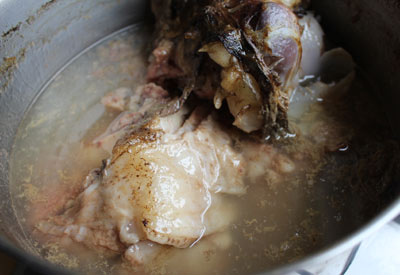|
|
Mast Cell Activation Disorder, histamine and bone broth |
As part of our Q&A series on histamine, Dr Joneja was asked whether drinking bone broth could have triggered a release of histamine and a major flare in one reader's MCAD. |

Question: I have mast cell activation with occasional anaphylaxis and was doing pretty well on ketotifen and other medications from Castells. I kept reading how good bone broth was for leaky gut and inflammation. I bought a pressure cooker and fresh frozen grass-fed beef marrow bones and soup bones from farmers market and pressure cooked them and immediately drank one cup. Major reaction! I have been flaring for four days since - not anaphylaxis, but moderate mediator release. I would have thought that pressure cooking, because it is faster, wouldn't cause major histamine release in bone broth, but am I wrong? Is pressure cooked bone broth high in histamines? Are all bone broths a bad idea for us no matter how they are cooked? I am 58, female and post-menopausal since age 52. Your question allows me to explain some misconceptions about mast cell activation disorders and histamine excess, or sensitivity, and the role of food components in these conditions. Mast cell activation disorder (MCAD) involves degranulation of overly large numbers of mast cells in the body, initiated by a variety of different triggers. Mast cells are white blood cells, located in tissues throughout the body, which manufacture and store inflammatory mediators within intracellular granules. They are essential in providing the active biochemical agents that help fight disease and other threats to the body, and keep us safe. However, in MCAD, for often unknown reasons, there are far more mast cells than normal, so when they are activated by any number of events, the mediators they contain are released in excessive quantities, in a process called degranulation. This results in symptoms typical of allergy, up to and including anaphylaxis. Histamine is one of the most important of the mediators released in this process and many of the symptoms resulting from mast cell degranulation are a due to excessive histamine. A discussion of the effects of histamine can be found in my article here. However, when the mast cell degranulates, many other mediators in addition to histamine are released, each of which has its own effect and resultant symptoms. This is in contrast to histamine sensitivity, or intolerance, where excess histamine alone is responsible for the symptoms. In looking for culprits in both MCAD and histamine sensitivity most people assume that foods and beverages are the triggering agents. However, in many cases mediators, including histamine, are released in response to a variety of other factors including inhaled and injected allergens, infection, trauma, autoimmune disease, in fact any condition that involves activation of the immune system. Without doubt, dietary factors play an important role in both MCAD and histamine sensitivity or intolerance. In the former, components of food most frequently act as allergens or intolerance triggers that initiate mast cell degranulation. In histamine sensitivity, excessive quantities of histamine may be ingested from histamine-containing and releasing foods. Obviously, the latter can augment the histamine released in mast cell degranulation and increase the symptoms from that source. So a histamine-restricted diet is essential in the optimal management of both conditions. And now to your specific question: can bone broth be a source of excess histamine? From the above discussion you can see that this is not a simple answer. As a direct source of histamine it is a very unlikely offender. There is no reason to suspect that histamine is present in the bone broth. However, the process of long slow cooking, and probably pressure cooking, does lead to breakdown of the bones and the marrow, with release of many different ingredients that have the potential to act as allergens or intolerance triggers for mast cell degranulation in sensitive individuals. Proteins of various types, fats, gelatin from collagen, and several other constituents may lead to the release of mediators, including histamine, which would explain your reaction to the bone broth. I would strongly urge you to avoid such food derivatives in the future and follow a histamine-restricted diet as far as possible to reduce your risk of mediator release and its consequences. Further question: Please thank Dr Joneja for her thorough explanation. I appreciate her responding to me. It is most helpful. If I may, I would like to ask one follow up question to her answer. Dr Joneja says: The information from The Mayo Clinic is quite correct: certain additives, especially tartrazine and other azo dyes, benzoates and probably sulphites, can lead to an increase in histamine in sensitive people. We do not yet have research to show the mechanism whereby this occurs. There is some thought that perhaps mast cell degranulation may be involved, but no clear evidence so far. As you will read in all of my publications, your safest diet will consist only of pure foods – none with labels that have passed through manufacturing plants! Avoid the histamine-containing and -releasing foods in my published directives for a histamine-restricted diet and make all your meals “from scratch”. This will provide you with the best possible diet for your condition. August 2015
|
|
NB Information on this site is not a substitute for medical advice and no liability can be assumed for its use. Top of page
|












